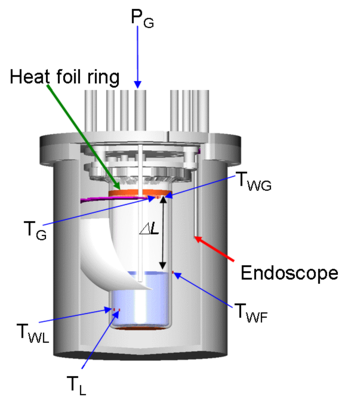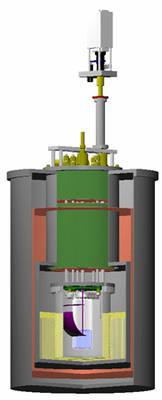non–isothermal drop tower experiments with cryogenic liquids
introduction
Knowledge of the dynamic behaviour of cryogenic fluids under the influence of abrupt accelerations changes and heat fluxes is of key importance for cryogenic propellant management in space vehicles.
The goals of these experiments are the investigation of the underlying physical mechanisms and quantification of the influence of the non-isothermal conditions on the dynamical behavior of the interface between a cryogenic liquid and its vapor upon step reduction of gravity in axisymmetric container geometries. Accordingly the dynamical wetting process in this single species 2-phase system is substantially influenced by thermal effects - heat flux from the container wall, phase transition at the interface, excessive evaporation in the vicinity of the contact line, nucleate boiling on the container wall, etc. This results in temperature dependant increase of the dynamic contact angle due to several known physical mechanisms – thermocapillary (Marangoni) convection, vapor recoil and the evaporation. Thus the interface oscillations during the reorientation are influenced and their frequency and damping behavior respectively. Any formation of a liquid layer on the container wall is prevented and the end equilibrium shape is also changed. The biggest change is by the behavior of the contact line – the intensification of the non-isothermal conditions can turn the aperiodic movement of the contact line into a pronounced oscillatory movement. This interface behavior was known until recently only for 2-species 2-phase systems with storable liquids, attributed to the thermocapillar convection induced by the presence of non-condensable gas in the gas phase. Our recent experiments with liquid argon show that this also true for single species 2-phase systems. As soon as nucleate boiling gets initiated, an increased coupling between movement of both the contact line and the center axial interface point is observed, alongside with an oscillatory pressure increase.
It is clear that the interface dynamics can not be any longer described by the characteristic for the isothermal flow dimensionless numbers (such as the Morton Mo, the Ohnesorge Oh and the Weber We numbers). Instead of this, in the case of acting thermocapillary convection the Weber Marangoni WeM is used, taking into account the characteristic difference between the container wall and the liquid, and the temperature gradient of the surface tension.
experimental setup
The main objective by the development of the experimental setup is the imposing of predefined non-isothermal cryogenic conditions in the test cell (the cylinder, depicted as partly filled with a blue liquid, seen inside of the of experiment chamber on Fig. 1) and the temperature detection at certain points on the container walls (TWG, TWF and TWL) and in cryogenic liquid/vapour (TL and TG) phases. Through the ring heat foil axial wall temperature gradients (TWG - TWF)/∆L towards the interface are created. A different cryogenic liquid from the test cryogenic liquid is used for the cooling bath (depicted yellow on Fig.2): liquid nitrogen for experiments with liquid argon and methane, liquid helium for experiments with liquid neon and hydrogen. The pressure is measured through a pressure sensor outside the cryogenic region via pressure transducer. The interface oscillations are detected through a CCD camera recording at 125 fps via the endoscope.


The funding of the drop tower flights and the funding of the research project by the German Federal Ministry of Education and Research (BMBF) through the German Aerospace Center (DLR) under grant number 50 RL 0921 are gratefully acknowledged.
publications
Kulev, N., Dreyer, M. E.: Drop Tower Experiments on Non-isothermal Reorientation of Cryogenic Liquids, Microgravity Sci. Technol. 22 (4), 463-474 (2010).


 "
"